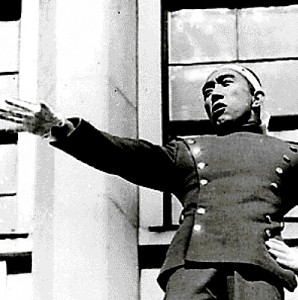This Day in History: November 25th- The Mishima Incident
This Day In History: November 25, 1970
 Yukio Mishima was born as Kimitake Hiraoka in 1925. Often referred to as the “Japanese Hemingway,” Mishima was arguably the best known Japanese author of the twentieth century. Many of his works were translated into English, and he was nominated for the Nobel Prize in Literature on three occasions.
Yukio Mishima was born as Kimitake Hiraoka in 1925. Often referred to as the “Japanese Hemingway,” Mishima was arguably the best known Japanese author of the twentieth century. Many of his works were translated into English, and he was nominated for the Nobel Prize in Literature on three occasions.
Mishima was an enigma wrapped around a swirling vortex of contradictions. For a man so offended by the influence of Western culture, his home was decorated in overblown Victorian opulence. He was an ardent Japanese patriot, but was seemingly terrified by the idea of combat and managed to avoid service during WWII via a false tuberculosis diagnosis, when he simply had a cold. Gay, he married a beautiful woman and gave the outward appearance of having the perfect conventional union, children and all.
And yet, Mishima spoke out frequently about the materialism and emptiness of post-war Japanese society and felt it was vital to encourage the values of medieval Japan. For example, Mishima felt the divinity of the emperor should be reinstated, not so much because the actual living emperor was inherently divine, but rather that his divinity came from embodying the living essence of Japan. Mishima also felt that bushido (‘the samurai way’) should be followed once more.
To add to his contradictory nature, although not a militarist, claiming that “… most foreigners mix up militarism and the samurai spirit,” Mishima formed his own militia in 1968. The Tatenokai (Shield Society) was made up of roughly 100 college students who learned martial arts and physical discipline under Mishima’s tutelage and swore to protect the emperor.
By 1970, Mishima spoke increasingly of the lack of “great causes” worth dying for in modern Japanese culture. In an interview, he described the difference between the samurai notion of killing oneself as “brave hara-kiri,” as opposed to the Western idea of suicide as “defeatist.”
In Mishima’s case, he had definitely planned his demise out beforehand. He had written the traditional death poems (jisei no ku) and provided for his wife and children well in advance.
On November 25, 1970, “Japan’s Renaissance Man” Yukio Mishima, stood before a crowd of over one thousand servicemen in Tokyo at the national Self-Defense Forces headquarters. He challenged them to rise up against Japan’s post-WWII constitution, which prohibited war and imposed strict limitations on the country’s military capabilities. Rather than do so, the soldiers merely mocked him.
After delivering his speech and seeing his attempted coup had failed, Mishima and four of his followers reentered the room they had previously barricaded themselves in and performed Harakiri, also sometimes called Seppuku. This ritualistic suicide involves the person driving a razor-sharp blade into their abdomen and slicing it open as their second simultaneously beheads them in a precise manner to leave a bit of skin still attaching the head to the body so that the head hangs down in front as if in embrace.
Unfortunately for Mishima, his second, Masakatsu Morita, was unsuccessful at his job and after several hacks, Hiroyasu Koga had to take over and complete the beheading.
Right after the failed coup, a Tokyo police official was quoted as saying,
Mishima has gone and actually done what these rightists only talk about. And it is not only the rightists who are stirred. Here in Japan, there must be thousands of frustrated people. They have no outlet for their pent-up feelings.
Suddenly, along comes Mishima and his young followers of the Shield Society. They not only preach restoration of the emperor-centered values of traditional Japan, they try to do something about it.
That kamikaze spirit still has appeal in this country. You may be a rightist, you may be a leftist, you may be quite non-ideological, but with a grudge against, say, your boss. Normally, you don’t do anything about your grudges or your frustrations, you hold them in.
But when you read or hear about an act like Mishima’s – well, there is always the chance that you might want to go out and do the same.
If you liked this article, you might also enjoy our new popular podcast, The BrainFood Show (iTunes, Spotify, Google Play Music, Feed), as well as:
- How Were Kamikaze Pilots Chosen?
- Saburō Sakai: The Samurai of the Skies
- The Man Who Fought in WWII With a Sword and Bow
- A Japanese Soldier Who Continued Fighting WWII 29 Years After the Japanese Surrendered, Because He Didn’t Know
- Origins of the Jedi (and Other Star Wars Stuff)
| Share the Knowledge! |
|





“For a man so offended by the influence of Western culture, his home was decorated in overblown Victorian opulence. He was an ardent Japanese patriot, but was seemingly terrified by the idea of combat and managed to avoid service during WWII via a false tuberculosis diagnosis, when he simply had a cold. Gay, he married a beautiful woman and gave the outward appearance of having the perfect conventional union, children and all.”
In other words, he was just another cowardly fool, like most every other self-styled “artist” throughout history. Good riddance.
I am amazed to find yet ANOTHER page at “Today I Found Out” that is utterly worthless and in need of being deleted. This topic is totally disgusting. The individual’s degrading interests and actions were completely worthless and outrageously offensive toward almighty God, who gave all of us our lives. Mr. Mishima’s thoughts and deeds help none of us in the “west” or in the “east” to lead our lives in a meaningful way.